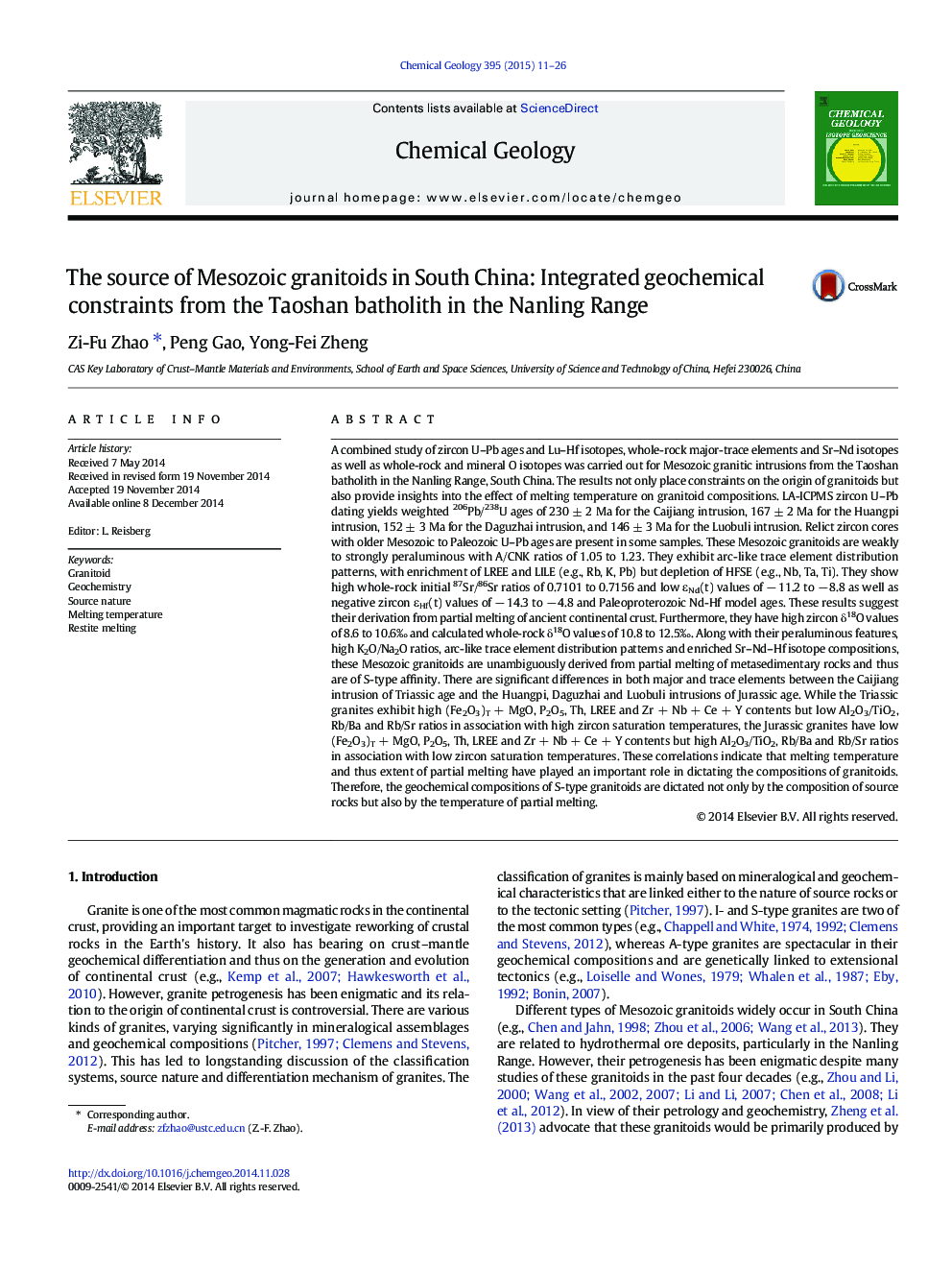| کد مقاله | کد نشریه | سال انتشار | مقاله انگلیسی | نسخه تمام متن |
|---|---|---|---|---|
| 4698577 | 1637578 | 2015 | 16 صفحه PDF | دانلود رایگان |

• An integrated geochemical study is necessary for decoding of granite petrogenesis.
• Melting of metasedimentary restites can give rise to I- to A-type like granites.
• Temperature and thus extent of partial melting are a key to granite compositions.
• Zircon O isotopes have greater bearing on petrogenetic classification of granites.
A combined study of zircon U–Pb ages and Lu–Hf isotopes, whole-rock major-trace elements and Sr–Nd isotopes as well as whole-rock and mineral O isotopes was carried out for Mesozoic granitic intrusions from the Taoshan batholith in the Nanling Range, South China. The results not only place constraints on the origin of granitoids but also provide insights into the effect of melting temperature on granitoid compositions. LA-ICPMS zircon U–Pb dating yields weighted 206Pb/238U ages of 230 ± 2 Ma for the Caijiang intrusion, 167 ± 2 Ma for the Huangpi intrusion, 152 ± 3 Ma for the Daguzhai intrusion, and 146 ± 3 Ma for the Luobuli intrusion. Relict zircon cores with older Mesozoic to Paleozoic U–Pb ages are present in some samples. These Mesozoic granitoids are weakly to strongly peraluminous with A/CNK ratios of 1.05 to 1.23. They exhibit arc-like trace element distribution patterns, with enrichment of LREE and LILE (e.g., Rb, K, Pb) but depletion of HFSE (e.g., Nb, Ta, Ti). They show high whole-rock initial 87Sr/86Sr ratios of 0.7101 to 0.7156 and low εNd(t) values of − 11.2 to − 8.8 as well as negative zircon εHf(t) values of − 14.3 to − 4.8 and Paleoproterozoic Nd-Hf model ages. These results suggest their derivation from partial melting of ancient continental crust. Furthermore, they have high zircon δ18O values of 8.6 to 10.6‰ and calculated whole-rock δ18O values of 10.8 to 12.5‰. Along with their peraluminous features, high K2O/Na2O ratios, arc-like trace element distribution patterns and enriched Sr–Nd–Hf isotope compositions, these Mesozoic granitoids are unambiguously derived from partial melting of metasedimentary rocks and thus are of S-type affinity. There are significant differences in both major and trace elements between the Caijiang intrusion of Triassic age and the Huangpi, Daguzhai and Luobuli intrusions of Jurassic age. While the Triassic granites exhibit high (Fe2O3)T + MgO, P2O5, Th, LREE and Zr + Nb + Ce + Y contents but low Al2O3/TiO2, Rb/Ba and Rb/Sr ratios in association with high zircon saturation temperatures, the Jurassic granites have low (Fe2O3)T + MgO, P2O5, Th, LREE and Zr + Nb + Ce + Y contents but high Al2O3/TiO2, Rb/Ba and Rb/Sr ratios in association with low zircon saturation temperatures. These correlations indicate that melting temperature and thus extent of partial melting have played an important role in dictating the compositions of granitoids. Therefore, the geochemical compositions of S-type granitoids are dictated not only by the composition of source rocks but also by the temperature of partial melting.
Journal: Chemical Geology - Volume 395, 24 February 2015, Pages 11–26